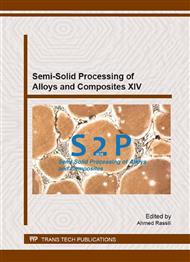[1]
Haga T., Kapranos P. on Journal of Material Processing Technology Vol. 130 – 131, 594, (2002).
Google Scholar
[2]
Kirkwood DH, Kapranos P, editors. on Proceedings of the 4th International Conference on Semi-Solid Processing of Alloys and Composites, Sheffield, UK, June 1996, University of Sheffield, (1996).
Google Scholar
[3]
Fan Z. on International Materials Review, Vol. 47, 49–85, (2002).
Google Scholar
[4]
Zhen, Z., Qian, Ma., Fan, S. Ji, Z. on Scripta Materialia, 207-211, (2006).
Google Scholar
[5]
H.V. Atkinson, D. Liu on Materials Science and Engineering: A, Volume 496, 1-2, 25, 439-446, (2008).
Google Scholar
[6]
U. A. Curle, G. Govender onTransaction of Nonferrous Metals. Society of China 20, 832-836, (2010).
Google Scholar
[7]
H.V. Atkinson on Progress in Materials Science, 50, 34 412, (2005).
Google Scholar
[8]
Haga T., Kapranos P. on Journal of Material Processing Technology, Vol. 130 - 131, 594, (2002).
Google Scholar
[9]
Nafisi S. and Ghomashchi R. on Journal of Materials Characterization, Vol. 57, 371, (2006).
Google Scholar
[10]
Ashby MF, Johnson K. Shaping profiles on Materials and Design, Oxford, UK: Butterworth-Heinemann, 246, (2002).
Google Scholar
[11]
Rosso M., Peter I., New frontiers for thixoforming, International Journal of Microstructure and Materials Properties, Vol. 8, Issue 1-2, 2013, pp.113-124.
Google Scholar
[12]
Zhen Z., Ma Qian, Ji S., Fan Z., The effects of rheo-diecasting on the integrity and mechanical properties of Mg–6Al–1Zn, , Scripta Materialia 54 (2006), 207-211, ISSN 1359-6462.
DOI: 10.1016/j.scriptamat.2005.09.032
Google Scholar
[13]
Kaufmann H., Wabusses H., Uggowitzer J., Aspects of the NRC semi-solid casting technology, Journal of Metallurgical and processing Technology, vol. 76, no1-2, pp.70-75.
Google Scholar
[14]
M. Rosso, I. Peter, G. Chiarmetta, I. Gattelli, Development of industrial components by improved rheocasting system, , International Journal of Materials Forming, p.787– 790, (2010) Vol. 3 Suppl 1, DOI 10. 1007/s12289-010-0888-8.
Google Scholar
[15]
M. Rosso, I. Peter, G. Chiarmetta, I. Gattelli, Extremely light weight rheocast components for auto motive space frame, Solid State Phenomena Vols. 192-193, pp.545-550 (2013), doi: 10. 4028/www. scientific. net/SSP. 192-193. 545.
DOI: 10.4028/www.scientific.net/ssp.192-193.545
Google Scholar
[16]
M. Rosso, I. Peter, Defect control on Al castings for excellent quality and improved performances through novel Rheocasting processes, TMS Annual Meeting Volume 2, 2012, Pages 403-410, 141st Annual Meeting and Exhibition, TMS 2012; Orlando, FL; United States; 11 March 2012 through 15 March (2012).
DOI: 10.1002/9781118357002.ch52
Google Scholar
[17]
Chiarmetta G. on Proceedings of 6th International Conference on Semisolid processing of alloys and composites, Turin, Italy, (2000).
Google Scholar
[18]
G. Chiarmetta on 4th Inter. Conf. on Semi-Solid Processing of Alloys and Composites, D. Kirkwood and P. Kapranos, eds., Department of Engineering Materials, The University of Sheffield, Sheffield, England, 204- 207, (1996).
Google Scholar
[19]
M. Rosso, E. Romano E, P. Giordano, et al. on Proceedings of the 7th International Conference on Semi-Solid processing of Alloys and Composites. Japan, National Institute of Advanced Industrial Science and Technology, Vol. 151-156, (2002).
Google Scholar
[20]
M. Rosso, I. Peter, R. Villa on Journal of Solid State Phenomena Vol. 141-143, 237-242, (2008).
Google Scholar
[21]
G.L. Chiarmetta, M. Rosso, 6th International Conference on Semisolid processing of alloys and composites, Proceedings Editors, Turin, Italy, (2000).
Google Scholar
[22]
G.L. Clauser, A. Ravaioli, F. Ciselli, M. Vassallo, Proceedings of the 4th International Conference on Semisolid processing of alloys and composites, Sheffield, 234-238, June (1996).
Google Scholar
[23]
Gattelli I., Chiarmetta G., Boschini M., Moschini R., Rosso M., Peter I., New generation of brake callipers to improve competitiveness and energy savings in very high performance cars, diffusion and defect data, solid state data. Part b, solid state phenomena, p.10.
DOI: 10.4028/www.scientific.net/ssp.217-218.471
Google Scholar
[24]
Moschini R., Molina R., Production of hollow components in high pressure die casting through the use of ceramic cores,. HTDC, Vicenza Feb (2012).
Google Scholar
[25]
Campbell J., Castings2nd edn, p.443–452; 2003, Oxford, Butterworth-Heinemann.
Google Scholar
[26]
Campbell J., Casting practice; 2004, Oxford, Butterworth Heinemann.
Google Scholar
[27]
Rosso M., Malerba V., Molina R., Il controllo qualità in fonderia ed applicazione della teoria del Bi-film, 34° Conv. AIM, Trento (Italy) (2012).
Google Scholar


